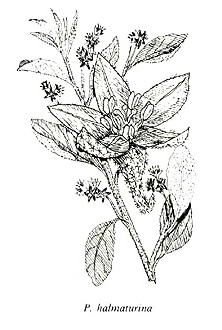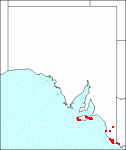|
Pomaderris halmaturina
Citation:
J. Black, Trans. R.Soc. S. Aust. 49:273 (1925).
Synonymy: Not Applicable Common name: Kangaroo Island pomaderris.
Description:
Shrubs 2-3 m high; leaves narrow-elliptic to ovate-elliptic, dentate, denticulate or entire, flat, sometimes with the veins deeply impressed above, the blade varying greatly in size on each branch but the largest usually 3-4 x 1.2-2 cm, densely stellate-tomentose and often ferruginous on the veins below, less tomentose above and often with stellate hairs along the margin only and simple hairs along the midrib, cuneate or subobtuse at the base, petioles of the longest leaves 4-10 mm long.
Flowers in axillary or terminal racemes or small little-branched panicles usually not exceeding the last leaf by more than 2 cm; pedicels 1-4 mm long; peduncles, pedicels and the outside of the calyx grey-stellate-tomentose; ovary c. 1 mm long; sepals 2-2.5 mm long; petals 0; style divided almost to the base (?always), clavate, with almost capitate stigmas; ovary extending well above the insertion of the calyx, densely long-hairy.
Fruitlets opening by a valve half their length.

| Pomaderris halmaturina inflorescence and flower.
|
Image source: fig 428c in Jessop J.P. & Toelken H.R. (Ed.) 1986. Flora of South Australia (4th edn).
|
|
|
Distribution:
|
Usually grows near rivers.
|
Conservation status:
native
Flowering time: Oct., Nov.
|

SA Distribution Map based
on current data relating to
specimens held in the
State Herbarium of South Australia
|
Biology:
No text
Taxonomic notes:
The SE specimen from south of Naracoorte appears to differ from the KI material only in the terminal inflorescences being up to 5 cm long. It to some extent resembles the Vic. species P. aspera which has larger leaves and very much larger inflorescences. Black considered that P. halmaturina differed from P. apetala in having leaves hairy above and in having racemes not panicles (both of which characters are now known to be inconsistent) and in having a more deeply divided style. Intermediates make it difficult to separate it from P. oraria. It is possible that specimens with the leaf veins not prominently impressed above should be transferred to P. oraria.
Author:
Not yet available
|

